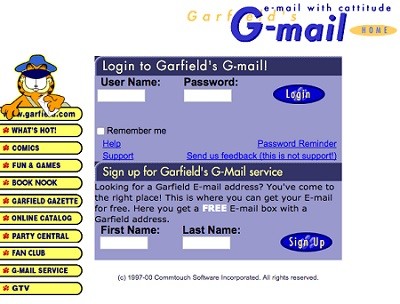4 WTF Tales From The Early Days Of The Internet

If the internet was a person, it'd be a curmudgeonly old jerk who loves complaining, nostalgia, and batshit conspiracy theories. But it wasn't always like this, though: like the rest of us, it went through a couple of weird, awkward young years while trying to find its footing in the world ...
The First Version of Gmail Was a Garfield-Themed Email Provider
According to the internet, Garfield is unfunny, hack garbage that's good for nothing except endless remixes ... and the nightmares which follow those remixes like a cannibal serial killer stalking a naive college coed.

We think that's a little unfair. It might not be the funniest or most ridiculous cartoon ever made (that'd be "Loss"), but it did give us the dog cum cartoon, a badass animated series, the dog cum cartoon, and of course, Gmail.

Back in the '90s, the internet was a barely-there collection of forums, hobbyist pages, and shock sites. Brands were few and far between -- unlike today, where it's impossible to go a whole seven seconds without having some brand obnoxiously bukkake their slogan onto your-- ARBY'S: WE HAVE THE MEATS -- eyeballs.
One of the first entertainment brands to jump on the 'net was Garfield in 1996, with a website where fans could find old and current comic strips, a collection of bulletin boards, and even a blog by the comic's creator, Jim Davis. It was pretty good by all accounts, but it lacked something ... a certain je nai sai quoi that the true diehards would kill for. It took Davis two years and a lasagna tray of peyote, but he finally figured it out.

Opening in 1998, Garfield Mail -- based at gmail.garfield.com -- was an email provider for, by, and only for people with extreme "cattitude," with anyone who signed up earning themselves a hella (cat) fancy @catsrule.garfield.com email address. It's also thought that having one of these email addresses was a prerequisite for accessing the official site's bulletin boards, so alongside being rad as hell, users could also download as much sweet, sweet fanfiction as their hearts and loins desired.
The service carried on until sometime in the early '00s before disappearing off the face of the planet -- and not because it was absorbed/destroyed by Google. It just vanished. Except vanished doesn't mean dead. When Bryan Menegus investigated Garfield Mail in 2018, he found that not only were there several working email addresses with the @catsrule.garfield.com suffix but that an email address with this suffix appears twice in a massive cache of emails belonging to the Syrian government that was released by Wikileaks in 2012.
So, who knows: maybe the site's users are still out there, waiting for Google et al. to collapse before returning to the surface -- after which, and with backing from President Bashar al-Assad, they'll conquer the planet in the name of Garfield, Odie, and Jon. Or it'll completely die out after everyone forgets their password. Whichever, really.
The First Computer Worm Was a Harmless Experiment (Which Nearly Destroyed the Early Internet)
Imagine someone who creates harmful computer programs. If you're anything like us, you're probably picturing someone in a dark room, smirking to themselves as the code on the monitor reflects off their hacker shades. The type of person you definitely aren't picturing is a young comp-sci nerd typing, sobbing, and sweating, as he tries in vain to reverse the cybergeddon he just unleashed ... and yet, this is how the first computer worm attack went down.
At 8:30 p.m. on November 2, 1988, a 20-something graduate, Robert Morris, introduced a worm onto the net using a computer at the Massachusetts Institute of Technology. The purpose of this worm, according to Morris, wasn't to damage the network: it was simply to spread as far and wide as it could, without anyone knowing -- ostensibly just to see whether it could be done. Unfortunately, Jurassic Park was still five years out at this point, so Morris didn't realize how badly he'd messed up.
Within less than a day, Morris' worm had infected over 6,000 computers of the 60,00 computers attached to the then-internet, including computers at MIT, Harvard, Princeton, NASA, and the Lawrence Livermore National Laboratory. Worse still, the worm wasn't some benign digital hitchhiker: it was a murderous hitchhiker which reveled in grinding computers into a gray paste and, by extension, causing millions of dollars in damage and delays.
As computer technicians around the country tried to figure out a fix, Morris contacted two friends and not only confessed to the crime but asked one to relay a message across the net with details on how to remove the worm. It was a magnanimous gesture which ended up saving ... absolutely no-one because the network was so badly damaged. You know who did get a message, though? The New York Times, from one of Morris' friends -- who used the information to unearth Morris' identity and lead the FBI to his doorstep.
Morris was soon indicted under the 1986 Computer Fraud and Abuse Act. Still, despite the damage caused by his worm, he only received a fine, probation, and several hundred hours of community service. However, the whole incident began a digital arms race among companies and institutions alike as they realized that the next attack might not be so (relatively) benign.
The First Thing Sold Online Was a Baggie of Weed
Although it's oft-said that there's nothing you can't buy on the internet, we invite you to test this theory for yourself by hopping on the dark web and buying a bunch of 'shrooms. Spoilers: you can't because the authorities will have an armed assault team up your ass within five seconds after your delivery touching down and also, double-spoilers, it's usually a bad idea to try anything recommended by a comedy website.
This is especially ironic, though, considering the first thing ever sold on the internet, the thing which birthed an industry today worth over $everal TRILLION was ... a baggie of drugs.
As John Markoff describes in What the Dormouse Said: How the Sixties Counterculture Shaped the Personal Computer Industry, a group of students from Stanford and MIT used the granddaddy of the internet, Arpanet, to "quietly arrange the sale of an undetermined amount of marijuana" in 1972. "Before Amazon, before eBay, the seminal act of e-commerce was a drug deal."
It was also, crucially, the first and only time that computer nerds have ever been cool.
The First Bot Was a (Poorly-Coded) Genocide Denier
1991's Terminator 2 promised us that when the bots came, they'd be bearing nothing less than the total extermination of mankind -- delivered by an army of grinning, malevolent, DTF deathdroids.

Well, it's 2020, and we've got bad/good news: the machines are finally here ... but they're too busy shitposting on social media to bring about the end of days. It's estimated that of the 330+ million active users on Twitter, anywhere between nine and 15 percent are "social bots" -- automated programs disguised as humans which do, well, whatever their fleshy overlords tell them, from boosting hashtags to auto-responding to tweets containing a specific keyword to propagating conspiracy theories and other heinous horseshit.
The thing is, though, these kinds of bots have been an irritating component of online discussions since Usenet -- a precursor to Reddit and other discussion board-type sites that was invented in prehistoric times (i.e., the 1980's), where hobbyists and fans of, well, anything, could link up and discuss . And it was a beautiful site ... until he arrived.
In 1994, Usenet came under attack from a sophisticated spammer calling themselves "Serdar Argic." If someone posted a message containing the word "Turkey," Argic would swiftly appear and subject them to a long, rambling diatribe about how the Ottoman Empire totally didn't genocide over 1.5 million Armenians between 1914 and 1923 ... and how actually it was the other way around.

Argic's posts would bring the entire site to a standstill, as veteran posters showed up to debunk his horseshit and/or tell him to piss off, while newbies showed up to antagonize him further ... which would result in him posting more deranged essays ... which brought more debunkers and antagonizers ... which brought more essays ... which brought more debunkers and antagonizers ... which brought more, you get the point.
Eventually, a crack team was formed to take Argic down for good. However, they soon found out that they couldn't because Argic was nothing more than a bot programmed to respond to any post which contained the word "turkey," regardless of whether the post was about the country or the delicious animal. Worse still, they couldn't shut off the bot because the hosting platform appeared to be hosted by Argic himself.
In response, Usenet was forced to adopt more stringent moderation policies, which in some communities translated to moderators having to manually read and approve every post made to their newsgroups. That's how toxic Argic was: when faced with the choice between reading the internet's innermost thoughts or dealing with this one guy's bullshit, they happily chose the former.
Whether because of these policies or because his parents finally evicted him, Argic vanished off Usenet within several months -- leaving behind several devastated newsgroups, a keyboard coated in chicken tendies crumbs, and a terrifying vision of what the internet would become.
Adam Wears is (allegedly) a comedy writer. Want to read other articles he's written for Cracked? Click here! Want to follow him on Twitter? Click here! Want to check out his website? Click here!